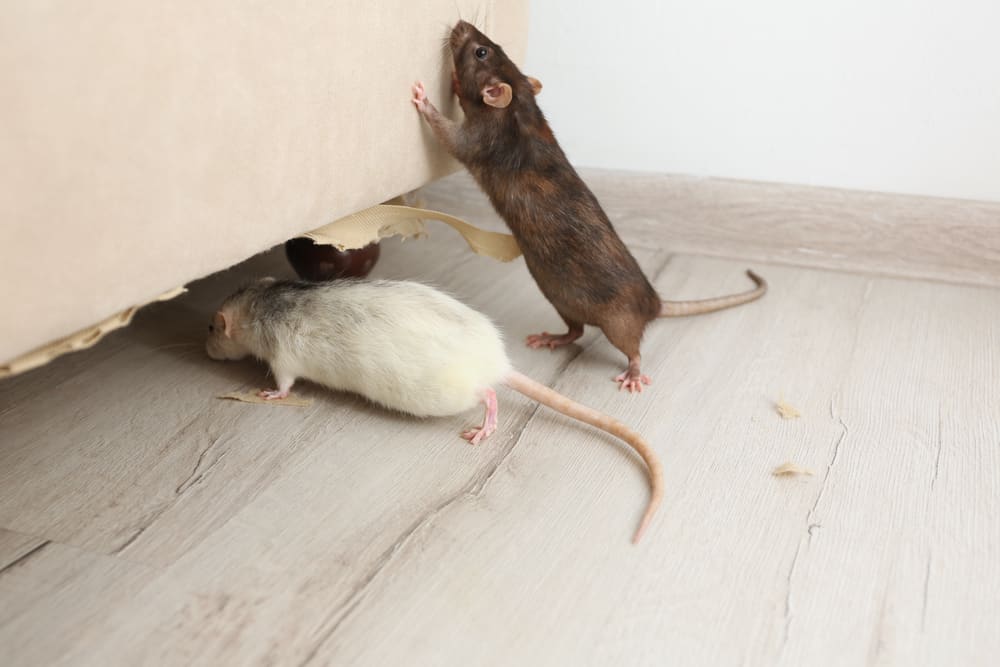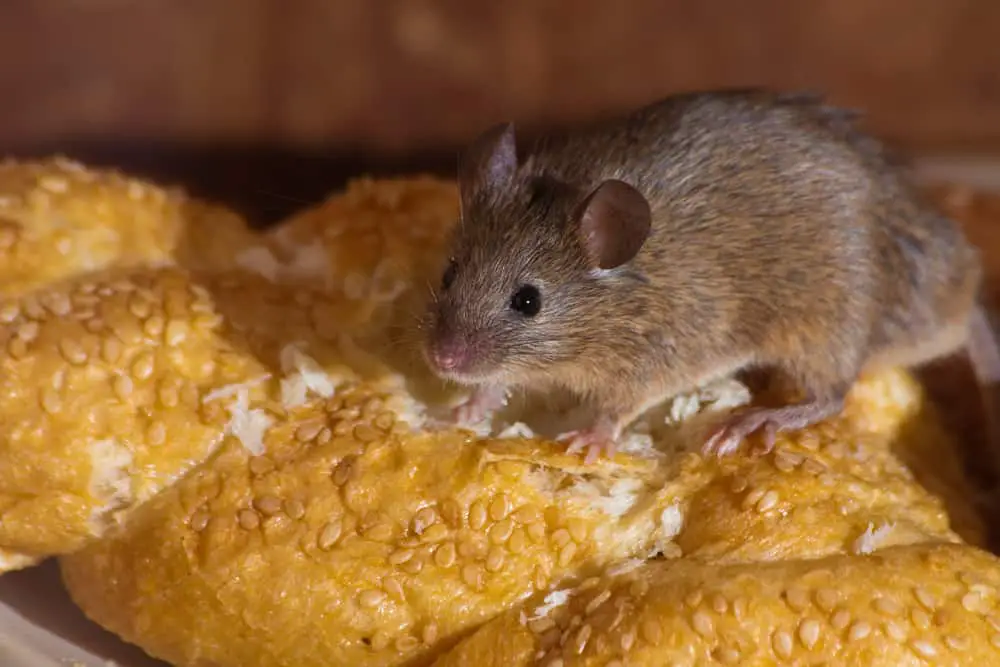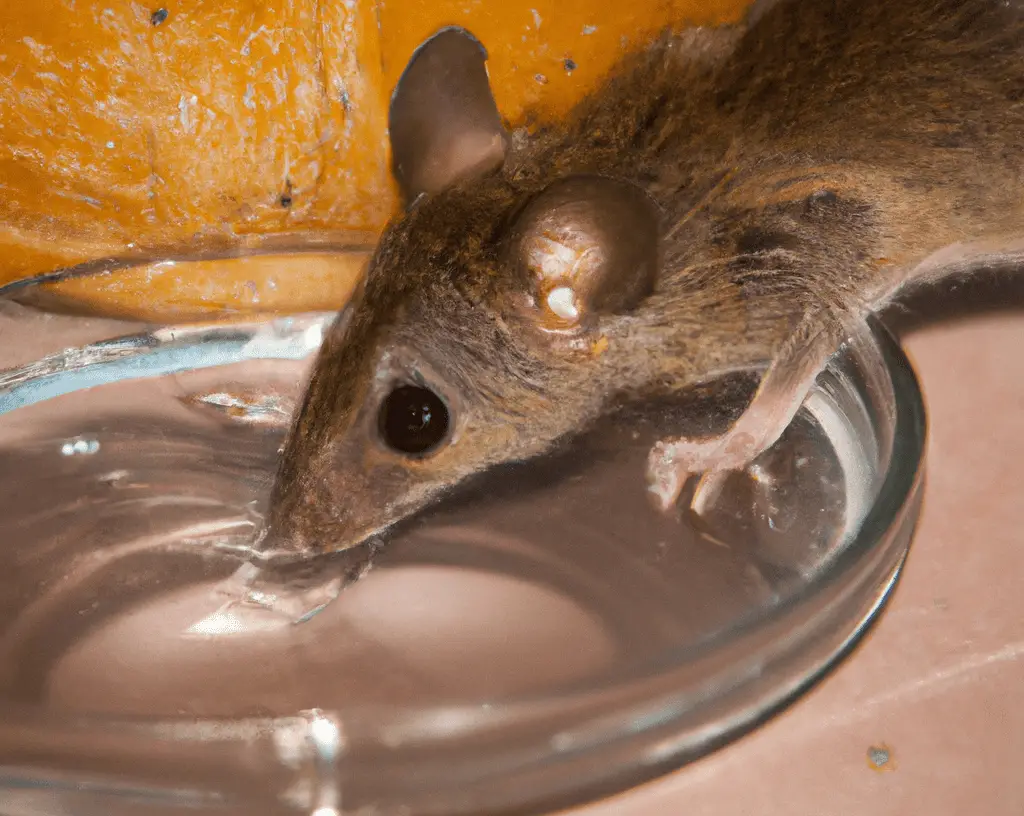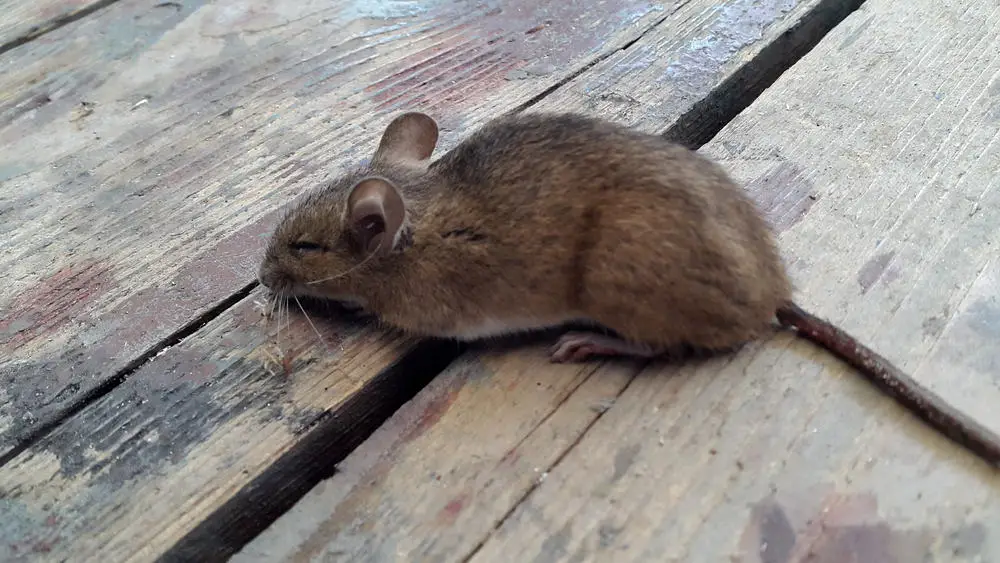Almost every home gets a visit from a rodent species every now and then. Some common rodents like wood mice, deer mice, and squirrels will just pass through to survive some harsh weather. Others, like the house mouse, will move in and set up camp. A female mouse can give birth to around 6 babies every 3 weeks, so it’s best to keep them out of your house.
If you have house mice, you will need to figure out how they got in, where they are nesting, and how to get them out. Attempting to remove house mice incorrectly can result in dead mice in the walls and bad smells for weeks. Decomposing mice can attract other pests and lead to diseases and other health risks. Figuring out how house mice are getting inside your home is the first step to keeping them out.
How Do House Mice Enter Homes?
Mice can squeeze into ridiculously tiny gaps and enter your home in a number of ways. Often cracks along your foundation or any entry point to the basement offer multiple ways in. Crawl spaces and gaps understairs, as well as below decks, are all places cracks form, and mice can enter. Water damage and vibrating pipes can cause gaps behind bushes and vegetation as well.
The house mouse is an excellent climber and can make it to first and second-story windows and vents. Any gap they can fit their head into, a mouse can squeeze through, and they can reach any area of your home. Regular exterior maintenance can help alert you to problems before they become mouse holes.
Attics and gaps under the roof are also easy entryways for mice. Heat rises, and attics will have many openings to release the heated air. Mice, often drawn to the warmth, will squeeze in and build their colony. Once in your home, mice can cause expensive damage and risk your and your pet’s health.
How to Tell If You Have a House Mouse?

Common rodents will make their way into your home either for a season or an extended time. Different rodent species need to be handled in different ways, and in some cases, the best idea is to call a pest customer care team. Sometimes you can handle it on your own, especially if it’s male or female house mice, but first, you need to identify them.
Characteristics of House Mice
The most identifiable characteristic of house mice is their dusty gray coats and cream belly. Deer mice are a darker brown color and usually nest outside, while yellow-necked mice have distinct features. House mice are usually only 2 1/2 to 4 inches long and can squeeze into very tiny holes. They need to eat constantly and spend most of their life looking for food.
A female house mouse mates frequently and can breed rapidly and can cause eruptions of mouse populations inside your home. Having a family of rodents in your walls may sound cute until you realize there will be at least 20 new mice that year. The family of rodents will continue to grow as all the first-generation offspring of female house mouse mates and reproduce at a similar rate to their mother.
Signs of House Mouse Infestation
If you think a rodent species is in your house, you will need to look for signs of infestation. Repeated signs can help you determine what animal is in your home and determine how to get rid of it. A house mouse leaves several common signs.
Mouse droppings are usually the first indicator that you have a pest problem. According to the centers for disease control and prevention, mouse feces can lead to several health issues for humans and domestic animals. Mice turds are common near our cereal grains and behind stoves where food waste settles.
Scratching noises at night coming from the walls and ceiling are also indicators that you may have a house mouse. When you turn on bright lights in the kitchen, you may see a mouse scurry out of sight. The presence of a house mouse can be noticed pretty quickly if you clean regularly and pay attention to cereal grain pantries and other food storage areas.
What Attracts House Mice?

House mice are the most common rodent species attracted to our homes. Each winter, they will try to move in to avoid the colder months outdoors. Pet food laying around outside and easy access to food can make house mice hang around. Mating is also an important function in mice, and so is nesting, which can be done in many areas of our homes. Using tips from the grain belt, remove these attractants to prevent a house mouse infestation.
| Attractant | Common Occurrences | Why It Attracts |
| Food | Kitchen, garage | Rodents eat up to 20 times a day |
| Water | Kitchen, bathroom | House mice need plenty of water |
| Nesting | Attic, garage, walls | Insulation and storage materials make good bedding |
| Warmth | Attic, garage, walls | Helps survive the winter |
| Mating | Attic, garage, walls | Mice are attracted to places other mice live |
| Shelter | Attic, garage, walls | Air bricks are quick shelter spaces for mice |
Food
The primary reason mice come into our homes is to find a food supply. If we create an environment with lots of food easily available to mice, they will move in with no hesitation. Availability of food isn’t just the obvious sources like pet food and food left out. House mice can break into your food supply and contaminate the food sources for everything else.
To get to food sources, mice will damage food packaging and can cause the degradation of food supplies in basement and pantry storage. The main function of mice is to find an environment with food and try to build an excess of food. Keeping mice away from your food can be difficult, especially if you live in the grain belt or other mouse-infested region.
To avoid eruptions of mouse populations that damage food packaging and cause the degradation of food supplies, you will need to protect your food sources. Food for domestic animals can be kept in metal containers to keep a mouse’s gnawing teeth away, according to centers for disease control and prevention. Clean your kitchen often to avoid an excess of food waste falling behind large appliances and counters, and take away an environment with food for the mice.
Water

Just like an excessive food source, leaking water can also cause mice to move in. Mice need a constant supply of fresh water and will move anywhere they can find that necessary resource. Drains and water pipes can be entry points for rats who are excellent swimmers. Most house mice can not survive swimming but will enter through small gaps in walls to find water in the bathroom.
Bright lights in bathrooms can help to keep mice from wandering out at night, but just like with an excessive food source, eventually, the mice will be tempted to risk it. Fixing all leaks and filling all holes in bathrooms that allow mice in can keep them out. Watch out for rat fleas spreading from the sewers to your linens which could lead to cat fleas and other pet problems.
Nesting
Monogamous mice will try to set up a long-term home in your walls and move into attics, crawl spaces, and anywhere that bedding can be found. To prepare for having babies, monogamous mice will eat into your insulation and cardboard and paper supplies. Mice can cause a lot of damage if they live undetected in storage rooms for many months.
According to disease control prevention, rat fleas and cat fleas can be transferred by house mice in your walls. Deer mice and yellow-necked mice mostly spend their time outside and are less likely to bring rat fleas inside. House mice, on the other hand, bring pests like rat fleas inside our homes.
Centers for disease control prevention recommend setting traps in places like attics, garages, and storage. Make sure to check the traps regularly to avoid dead mice rotting and attracting other, worse pests. Cats will help patrol these rooms and keep the house mouse population to a minimum.
Warmth

During the winter months, making it inside a home could mean life or death for a house mouse. In some climates, the winter is too harsh for these rodents to survive. The only thing left for them to do is try to find their way into any available structure. Quite often, that structure is our homes.
The heat coming from a nice toasty home will attract rodents from all over, and if they can find a gap, they will squeeze inside. Once inside, food, water, and other conveniences may be all that is needed to convince your uninvited guests never to leave. Keeping your home sealed tightly, especially before the winter months, is advised.
When the temperature starts to drop, take some time to walk the outside perimeter of your home. Look for any large gaps between doors, windows, or any other protrusion. Much like checking for drafts, keep an eye out anywhere a mouse may be able to slip in. They can fit through a gap the size of a dime, so look very carefully.
Once you have located all the ways, a mouse could get in use caulk, mouse-proof foam, or another sealing technique you have to keep them out. Keeping mice out of your home is much easier than removing them once they have made it inside.
Mating
Male mice will go to where female mice are. If you have neglected an area of your house and a female mouse has moved in, chances are you will have plenty of other rodents showing up. Females mate continually and produce over 50 offspring a year. If you have mice living in your home, chances are you have mice mating in your house, and the population will only continue to grow.
Finding out where the largest population of mice hangs out in your home and starting the exterminating there is a great way to go about preventing continued mouse breeding. Once you have disrupted the mating cycle and removed food sources and other mouse attractants, you should be able to prevent females from having any more litters while you trap the rest.
Shelter
Extreme heat, bad weather, and other climate issues can send rodents into your homes. Trying to keep mice out can be difficult if the weather is bad and they are desperate. Most of the time, rodents will just wait out the storm, but if they find food and water sources, they may move in for good.
It is a good idea to make sure the spaces where mice could seek shelter are not places where you store food or nesting materials. Keep traps and other mouse repellents in areas where you don’t clean regularly. Anywhere a mouse can take shelter from predators, the elements need to be sealed and protected.
If you work to make your home an uncomfortable shelter for a house mouse, they will most likely leave yours and go to someone elses. While it is impossible to stop all mice from entering your home, using the right course of action can help you from developing a dangerous house mouse infestation.

